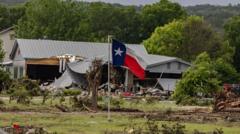Are Texas Officials Doing Enough with Emergency Alerts During Deadly Floods?

Understanding the Kerrville Flash Flood Tragedy: A Deep Dive
The catastrophic flash floods in Kerrville, Texas, have left a profound impact on the local community, resulting in the loss of 96 lives and leaving over 160 individuals missing. The devastating incident has raised serious concerns regarding emergency communication protocols, response times, and the overall effectiveness of disaster preparedness in the region. In this article, we will explore the timeline of events, the role of local officials, and the community's response to this tragic natural disaster. By examining the facts and implications, we aim to provide a comprehensive understanding of the situation while addressing some of the pressing questions surrounding the disaster.
The Timeline of the Kerrville Floods
On July 4, 2023, residents of Kerrville faced an unprecedented natural disaster as torrential rains led to flash flooding in the Texas Hill Country. The Guadalupe River swelled dramatically, rising several meters in just a few minutes after an estimated 100 billion gallons of rain fell in the region. The events unfolded rapidly, leading to confusion, panic, and tragedy. Here’s a concise timeline of the major occurrences:
- 4:22 AM: A firefighter upstream from Kerrville alerted the Kerr County Sheriff's Office about the rising water levels, requesting that residents be warned to seek higher ground.
- 4:30 AM: Initial assessments of the flooding situation began, but no warning was dispatched to residents immediately.
- 6:00 AM: Residents began to experience severe flooding and were trapped in their homes.
- 6:52 AM: The first alert from Kerr County's CodeRED system was sent out, nearly 90 minutes after the initial warning request was made.
- 8:00 AM: Emergency response teams mobilized, but by this time, many residents were already engulfed in floodwaters.
Official Responses and Communication Failures
The Kerrville flash floods raised critical questions regarding the effectiveness of local emergency services. During press conferences following the disaster, officials faced scrutiny over their response times and communication strategies. Kerr County Sheriff Larry Leitha stated that he was first alerted around 4 to 5 AM, but there was a clear lack of coordination and urgency in the early stages of the flood response.
One of the most concerning issues raised was the apparent delay in disseminating emergency alerts. Reports indicate that there was a significant lag between the initial request for a warning and the eventual notification to residents. This gap allowed many individuals to remain unaware of the imminent danger, contributing to the tragic loss of life.
The Role of Technology in Emergency Response
Technological failures also played a role in the challenges faced by emergency responders. Despite weather alerts being issued by the National Weather Service prior to the floods, local officials cited several factors that impacted the effectiveness of these warnings:
- Lack of Cell Service: Many residents in flood-prone areas experienced poor cell phone reception, making it difficult to receive timely alerts.
- Desensitization: Frequent alerts regarding potential flooding had led to a sense of complacency among some residents, who may have underestimated the severity of the situation.
- Intensity of the Storm: Local officials did not fully grasp the intensity of the storm as it unfolded, leading to a delayed response.
The Community's Grief and Response
The aftermath of the Kerrville floods has left the community grappling with immense grief and loss. With 96 confirmed fatalities, including 36 children from a nearby Christian camp, the emotional toll is palpable. Families are mourning the loss of loved ones while hoping for the safe return of the over 160 individuals still missing.
The community has come together to support one another during this difficult time. Search and rescue operations have mobilized over 2,100 responders, utilizing private helicopters, drones, boats, and even cadaver-detecting dogs to locate victims buried beneath debris. The response has showcased the resilience of the community, as volunteers and local organizations unite to provide assistance.
Federal and State Support
In light of the disaster, President Donald Trump signed a federal disaster declaration at the request of Texas Governor Greg Abbott. This declaration enables the Federal Emergency Management Agency (FEMA) to deploy resources to Central Texas and establish a disaster recovery center in Kerr County. This federal support is crucial in aiding recovery efforts and providing relief to affected families.
Lessons Learned and Future Preparedness
The devastating flash floods in Kerrville serve as a stark reminder of the importance of effective emergency preparedness and communication. As officials begin to assess the situation, several key lessons can be drawn from this tragedy:
- Improved Communication Protocols: There is a pressing need for local agencies to establish clear communication protocols that enable timely alerts to residents during emergencies.
- Investing in Technology: Upgrading communication systems and ensuring robust cell service in flood-prone areas can significantly enhance the ability to disseminate warnings effectively.
- Community Education: Educating residents about the significance of emergency alerts and the potential dangers of flooding can foster a more proactive approach to disaster preparedness.
Conclusion
The flash floods in Kerrville, Texas, have left an indelible mark on the community, highlighting the urgent need for improved emergency response systems. As families continue to grieve their losses and search for missing loved ones, it is essential for local officials to reflect on the lessons learned from this tragedy. By taking decisive steps to enhance communication and preparedness, they can help ensure that the community is better equipped to face future natural disasters.
As we move forward, the ongoing recovery efforts in Kerrville will require the collective strength of the community, alongside support from federal and state resources. The resilience and unity displayed in the face of adversity will be vital in rebuilding the lives shattered by this calamity.
FAQs About the Kerrville Flash Floods
What caused the flash floods in Kerrville, Texas?
The flash floods were primarily caused by an intense rainfall event that released an estimated 100 billion gallons of rain in a short period, leading to the rapid rise of the Guadalupe River.
How many people are still missing after the floods?
As of the latest reports, over 160 individuals remain unaccounted for following the floods, with search and rescue operations ongoing.
What steps are being taken to support the affected community?
Federal and state resources have been activated to assist in recovery efforts. This includes FEMA's involvement and the establishment of a disaster recovery center in Kerr County to provide support to affected families.
In the wake of such a tragedy, how can communities better prepare for natural disasters in the future? #KerrvilleFloods #EmergencyPreparedness #CommunityResilience
Published: 2025-07-10 19:37:03 | Category: wales



